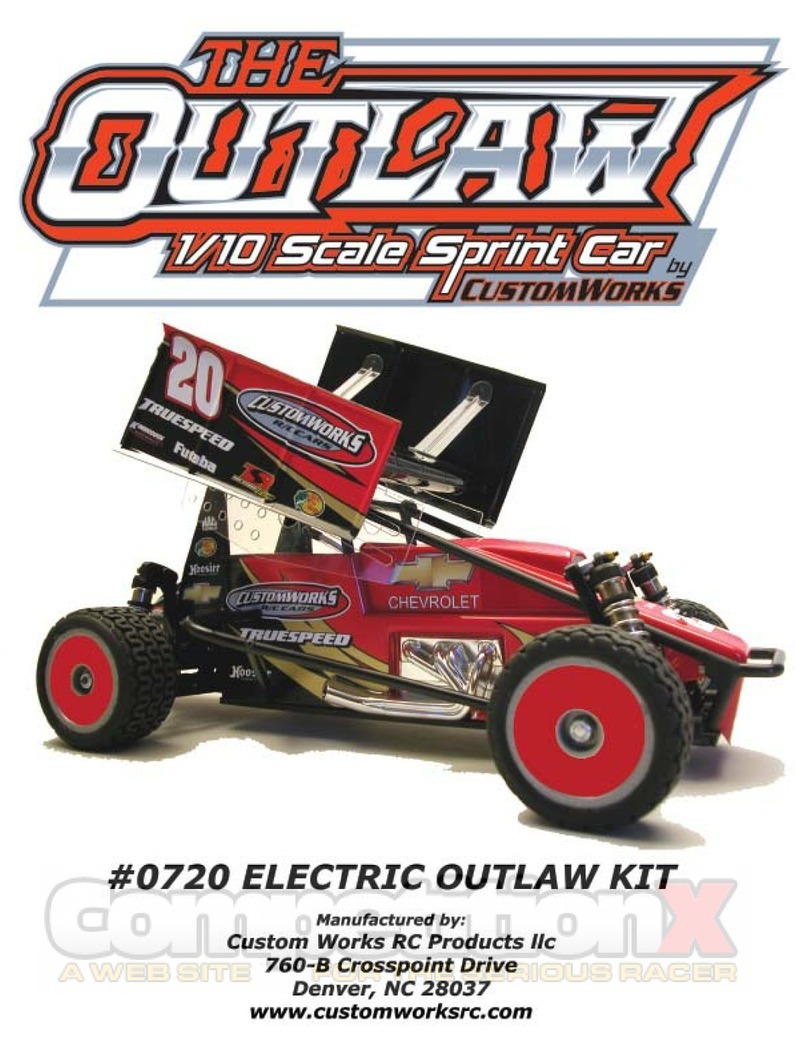
Bag JBag J
Bag JBag J
Bag J Shock AssemblyShock Assembly
Shock AssemblyShock Assembly
Shock Assembly
5274 Qty 4
4-40 x 1/2 SH Screw
-Parts for
Step#1
1437 Qty 4
Firm Bladder (BLACK)
1426 Qty 2
Short Shock Body
-Parts for
Step#2 1:1
1429 Qty2
Med Shock Shaft
1250 Qty 8
O- Ring
5230
- Attach 1436 Shock Piston to
Shock Shaft using 5230 E-Clips
to secure.
STEP #1 STEP #2
TIP: To press clip in easiest, compress the
clip so the diameter is a little smaller.Insert
open end of clip first, working counter-
clockwise to the bent end as shown.
- Snap Pivot Ball into the 5228 Ball End. Thread
the Ball End onto the Shock Shaft until the Ball
End is flush with the end of threads on the shaft.
- Press 1432 Eyelet Cap into 1431 Threaded
Shock Cap so that guide in the Eyelet Cap lines
up in the recess in the Threaded Shock Cap.
- Press the 1437 Firm Bladder (BLACK) into the
Threaded Shock Cap so the dome of the
bladder points away from the Eyelet Cap.
- Fill the Shock Body with oil to the top then
thread the Eyelet Cap assembly onto the
Shock Body until tight.
-NOTE: See shock filling tips for more
instructions.
SHOCK FILLING INSTRUCTIONS:
2) Slowly move the
shaft up and down
several times to allow
air bubbles to escape
to the top.
1) Holding the
shock upright,
fill with oil until
the top of the
body.
3) Refill with
oil to the top
of the shock
body.
5) Move the shock shaft in and out a
few times and then push it all the way
in. It should be easy to push the shaft
in until the eyelet hits the body.
4) Thread the Eyelet Cap
assembly onto the Shock
Body until it is hand
tight. Oil should seep
out of the bleed hole
in the Threaded Cap.
6) Then the shaft
should push itself
out to its full length
slowly.
7) If the shock does not push
out this far there is not enough
oil in it. Add just a little oil and
try steps 5-6 again.
8) If the shockrebounds too fast , or you cannot
push the shaft in until the eyelet hits the body, there
is too much oil. Loosen the cap about X full turns
and pump out a small amount of oil by pushing the
shaft in. Retighten the cap and try steps 5-6 again.
STEP #3
1434 Qty4
Shaft Guide
1435 Qty 6
Reatining Clip
1436 Qty4
Piston
M
5230 Qty 10
E-Clip
1:1
-Parts for
Step#3
1432 Qty4
Eyelet Cap
1431 Qty4
Threaded Cap
5228 Qty4
Short Ball End
5228 Qty4
Pivot Ball
1433 Qty4
Spring Collar
1488 Qty4
Spring
1407 Qty4
Spring Bucket
1408 Qty4
Mount Ball
5277 Qty 4
4-40 x 7/8 SH Screw
5217 Qty 4
4-40 Lock Nut
1436
1429 MED
1430 SHORT
1425 MED
1426 SHORT
1434
1435
1250
5228
1437
1432
1431
- Thread 1433 Spring Collar onto the
shock. Slide 1488 Spring onto the
shock and secure using the 1407
spring bucket as shown.
OIL
NOTE: Put a few
drops of oil on the
O-Rings!
OIL
OIL
OIL
Shock BagShock Bag
Shock BagShock Bag
Shock Bag
- Press 1250 O-rings into the
Shock Body followed by 1434
Shaft Guide. Retain using 1435
Clip.
- Attach the shock to the susp
arms in the locations shown.
- Install the shocks onto the screws
with the shoulder of the 1408
Mount Ball facing away from the
tower, secure with 5217 Nut.
- Press 5277 Screws thru the locations
shown. Fasten using 2214 Standoff.
1430 Qty2
Short Shock Shaft
1425 Qty 4
Med Shock Body
RIGHT
FRONT
1488
SPRING
1407
LEFT
REAR
5217
5217
5274
1433
5274
1408
1433
1408
5277
5277
5277 Screw on
the RF passes
thru the outer
most hole, 2nd
from the bottom.
5277 Screw on
the LF passes
thru the inner
most hole, 3rd
from the bottom.
5277 Screw
passes thru the
inner most hole,
4th hole from the
bottom row.
BUILD 2 SHORT & 2 MED
LENGTH SHOCKS!
- USE #1429 SHAFT WITH
#1425 BODY.
- USE #1430 SHAFT WITH
#1426 BODY .
SUGGESTED
40 WT R/C
SHOCK OIL.




























